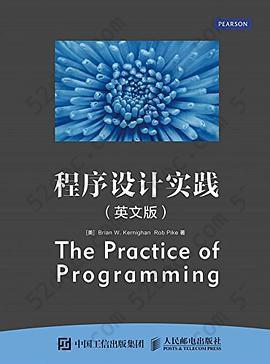注重体验与质量的电子书资源下载网站
分类于: 云计算&大数据 互联网
简介

程序设计实践: 英文版 豆 9.0分
资源最后更新于 2020-09-05 21:58:02
作者:Brian W. Kernighan
出版社:人民邮电出版社
出版日期:2016-01
ISBN:9787115407863
文件格式: pdf
标签: 程序设计 计算机 编程 计算机科学 软件开发 CS软件工程 计算机科学与编程 无index!
简介· · · · · ·
本书是计算机科学方面的经典名著,由计算机界极具影响力的两位专家Brian W. Kernighan和Rob Pike合著。书的内容围绕程序设计实践中的一系列问题展开,讲述对于程序员有共性的知识,以帮助各程序员写出更高效的程序。本书从排错、测试、性能、可移植性、设计、界面、风格和记法等方面,讨论了程序设计中既具有实际意义又具有广泛意义的思想、技术和方法。
本书值得每位梦想并努力成为程序员的人参考,值得每位计算机专业的学生和计算机工作者阅读,也适合作为程序设计高级课程的教材或参考书。
目录
Chapter 1: Style / 风格 1
1.1 Names / 名字 3
1.2 Expressions and Statements / 表达式和语句6
1.3 Consistency and Idioms / 一致性和习惯用语10
1.4 Function Macros / 函数宏17
1.5 Magic Numbers / 幻数19
1.6 Comments / 注释23
1.7 Why Bother? / 为何要在风格方面费心 27
Chapter 2: Algorithms and Data Structures / 算法与数据结构29
2.1 Searching / 检索30
2.2 Sorting / 排序32
2.3 Libraries / 库34
2.4 A Java Quicksort / 一个Java快速排序实现37
2.5 O-Notation / 大O记法40
2.6 Growing Arrays / 自增长数组41
2.7 Lists / 表44
2.8 Trees / 树50
2.9 Hash Tables / 散列表55
2.10 Summary / 小结 58
Chapter 3: Design and Implementation / 设计与实现61
3.1 The Markov Chain Algorithm / 马尔可夫链算法62
3.2 Data Structure Alternatives / 在多种数据结构之间选择64
3.3 Building the Data Structure in C / 使用C语言构建数据结构65
3.4 Generating Output / 生成输出69
3.5 Java 71
3.6 C++ 76
3.7 Awk and Perl / Awk和Perl 78
3.8 Performance / 性能80
3.9 Lessons / 经验教训82
Chapter 4: Interfaces / 接口85
4.1 Comma-Separated Values / 逗号分隔值86
4.2 A Prototype Library / 一个原型库87
4.3 A Library for Others / 一个给他人用的库91
4.4 A C++ Implementation / 一个C++实现99
4.5 Interface Principles / 接口原则103
4.6 Resource Management / 资源管理106
4.7 Abort, Retry, Fail?109
4.8 User Interfaces / 用户界面113
Chapter 5: Debugging / 调试117
5.1 Debuggers / 调试器 118
5.2 Good Clues, Easy Bugs / 线索明显、易于发现的错误119
5.3 No Clues, Hard Bugs / 线索不明、难以发现的错误123
5.4 Last Resorts / 最后的手段127
5.5 Non-reproducible Bugs / 不可重现的错误 130
5.6 Debugging Tools / 调试工具131
5.7 Other People's Bugs / 他人引入的错误 135
5.8 Summary / 小结136
Chapter 6: Testing / 测试139
6.1 Test as You Write the Code / 一边编码,一边测试140
6.2 Systematic Testing / 系统化测试145
6.3 Test Automation / 测试自动化149
6.4 Test Scaffolds / 测试脚手架151
6.5 Stress Tests / 压力测试155
6.6 Tips for Testing / 测试心得158
6.7 Who Does the Testing? / 谁来测试 159
6.8 Testing the Markov Program / 马尔可夫程序的测试160
6.9 Summary / 小结162
Chapter 7: Performance / 性能165
7.1 A Bottleneck / 瓶颈166
7.2 Timing and Profiling / 计时和剖析171
7.3 Strategies for Speed / 加速策略175
7.4 Tuning the Code / 代码调优178
7.5 Space Efficiency / 空间利用率182
7.6 Estimation / 评估184
7.7 Summary / 小结187
Chapter 8: Portability / 可移植性189
8.1 Language / 语言190
8.2 Headers and Libraries / 头文件和库196
8.3 Program Organization / 程序架构198
8.4 Isolation / 隔离202
8.5 Data Exchange / 数据交换203
8.6 Byte Order / 字节序204
8.7 Portability and Upgrade / 可移植性和升级207
8.8 Internationalization / 国际化209
8.9 Summary / 小结212
Chapter 9: Notation / 记法215
9.1 Formatting Data / 数据格式化216
9.2 Regular Expressions / 正则表达式222
9.3 Programmable Tools / 可编程工具228
9.4 Interpreters, Compilers, and Virtual Machines / 解释器、编译器和虚拟机 231
9.5 Programs that Write Programs / 写程序的程序237
9.6 Using Macros to Generate Code / 用宏生成代码240
9.7 Compiling on the Fly / 运行中编译241
Epilogue / 后记247
Appendix: Collected Rules / 规则汇编249
1.1 Names / 名字 3
1.2 Expressions and Statements / 表达式和语句6
1.3 Consistency and Idioms / 一致性和习惯用语10
1.4 Function Macros / 函数宏17
1.5 Magic Numbers / 幻数19
1.6 Comments / 注释23
1.7 Why Bother? / 为何要在风格方面费心 27
Chapter 2: Algorithms and Data Structures / 算法与数据结构29
2.1 Searching / 检索30
2.2 Sorting / 排序32
2.3 Libraries / 库34
2.4 A Java Quicksort / 一个Java快速排序实现37
2.5 O-Notation / 大O记法40
2.6 Growing Arrays / 自增长数组41
2.7 Lists / 表44
2.8 Trees / 树50
2.9 Hash Tables / 散列表55
2.10 Summary / 小结 58
Chapter 3: Design and Implementation / 设计与实现61
3.1 The Markov Chain Algorithm / 马尔可夫链算法62
3.2 Data Structure Alternatives / 在多种数据结构之间选择64
3.3 Building the Data Structure in C / 使用C语言构建数据结构65
3.4 Generating Output / 生成输出69
3.5 Java 71
3.6 C++ 76
3.7 Awk and Perl / Awk和Perl 78
3.8 Performance / 性能80
3.9 Lessons / 经验教训82
Chapter 4: Interfaces / 接口85
4.1 Comma-Separated Values / 逗号分隔值86
4.2 A Prototype Library / 一个原型库87
4.3 A Library for Others / 一个给他人用的库91
4.4 A C++ Implementation / 一个C++实现99
4.5 Interface Principles / 接口原则103
4.6 Resource Management / 资源管理106
4.7 Abort, Retry, Fail?109
4.8 User Interfaces / 用户界面113
Chapter 5: Debugging / 调试117
5.1 Debuggers / 调试器 118
5.2 Good Clues, Easy Bugs / 线索明显、易于发现的错误119
5.3 No Clues, Hard Bugs / 线索不明、难以发现的错误123
5.4 Last Resorts / 最后的手段127
5.5 Non-reproducible Bugs / 不可重现的错误 130
5.6 Debugging Tools / 调试工具131
5.7 Other People's Bugs / 他人引入的错误 135
5.8 Summary / 小结136
Chapter 6: Testing / 测试139
6.1 Test as You Write the Code / 一边编码,一边测试140
6.2 Systematic Testing / 系统化测试145
6.3 Test Automation / 测试自动化149
6.4 Test Scaffolds / 测试脚手架151
6.5 Stress Tests / 压力测试155
6.6 Tips for Testing / 测试心得158
6.7 Who Does the Testing? / 谁来测试 159
6.8 Testing the Markov Program / 马尔可夫程序的测试160
6.9 Summary / 小结162
Chapter 7: Performance / 性能165
7.1 A Bottleneck / 瓶颈166
7.2 Timing and Profiling / 计时和剖析171
7.3 Strategies for Speed / 加速策略175
7.4 Tuning the Code / 代码调优178
7.5 Space Efficiency / 空间利用率182
7.6 Estimation / 评估184
7.7 Summary / 小结187
Chapter 8: Portability / 可移植性189
8.1 Language / 语言190
8.2 Headers and Libraries / 头文件和库196
8.3 Program Organization / 程序架构198
8.4 Isolation / 隔离202
8.5 Data Exchange / 数据交换203
8.6 Byte Order / 字节序204
8.7 Portability and Upgrade / 可移植性和升级207
8.8 Internationalization / 国际化209
8.9 Summary / 小结212
Chapter 9: Notation / 记法215
9.1 Formatting Data / 数据格式化216
9.2 Regular Expressions / 正则表达式222
9.3 Programmable Tools / 可编程工具228
9.4 Interpreters, Compilers, and Virtual Machines / 解释器、编译器和虚拟机 231
9.5 Programs that Write Programs / 写程序的程序237
9.6 Using Macros to Generate Code / 用宏生成代码240
9.7 Compiling on the Fly / 运行中编译241
Epilogue / 后记247
Appendix: Collected Rules / 规则汇编249








